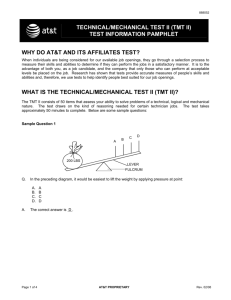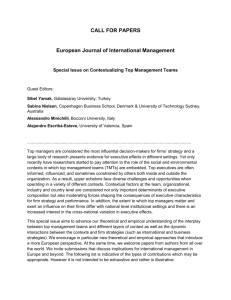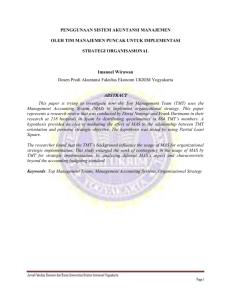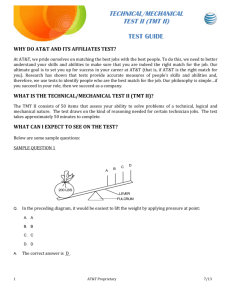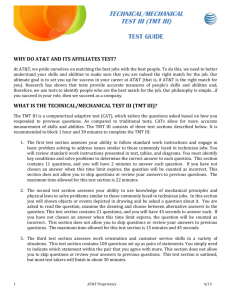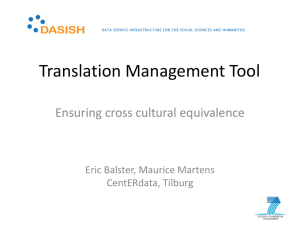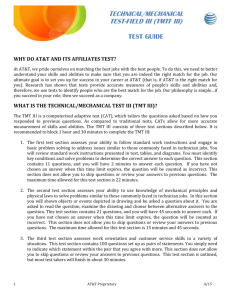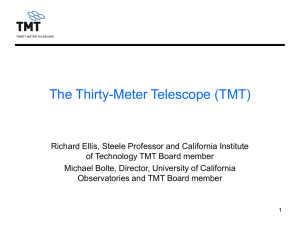Introduction and Project Overview
advertisement
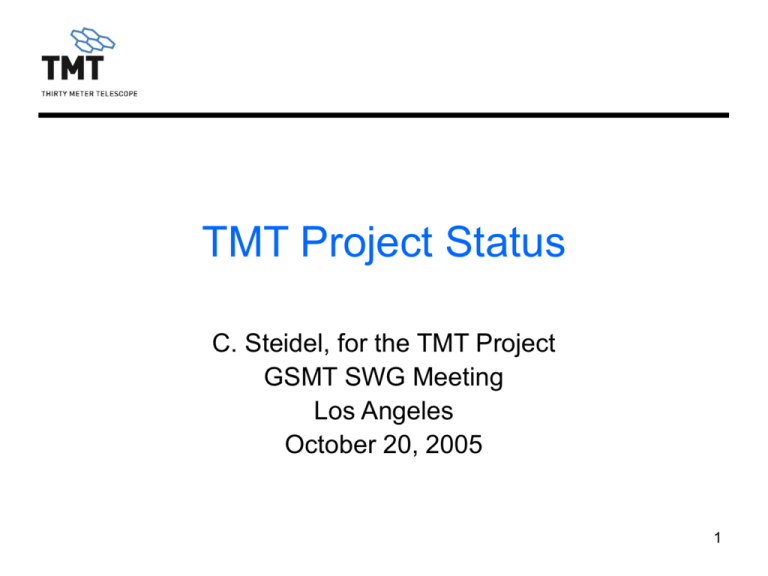
TMT Project Status C. Steidel, for the TMT Project GSMT SWG Meeting Los Angeles October 20, 2005 1 Contents Current Design Baseline Instruments and adaptive optics systems Capabilities and their connection to the GSMT-SWG report Operations models and US community access Schedule 2 The TMT Partnership TMT follows the NAS Decadal Survey recommendation that a public-private partnership is the best way to build & operate a US-led 30-m telescope Current partners (for Design and Development Phase) are: – – – – University of California Caltech ACURA (Canada) AURA (NSF) Although partners are currently “equal”, ultimate shares (e.g. of observing time) will be based on contributions to capital & operations. 3 TMT Precursor Studies TMT follows from a careful consideration of three, independently-conceived & independently-reviewed, point designs representing $6M total effort CELT (UC+Caltech) VLOT (Canada) GSMT (NOAO/Gemini) – Broad exploration of technical options – Positive reviews by outside reviewers – TMT consolidates the best aspects of these designs – Single reference design now established by the Project 4 TMT Overall Structure TMT governance established in June 2003 – Agreements between the partners – Formation of Science Advisory Committee equal membership/representation from each of the 4 partners – Formation of Board of Directors – Appointment of Project Manager, Gary Sanders (Apr 2004) Development Phases – Design Development Phase (2004-2008) $35M secured from G&B Moore Foundation (Caltech/UC) $17.5M from each of Canada and AURA (NSF) – Construction phase (2009 – 2014) – Science Operations (2015 - ) (Assuming timely delivery of capital & operational resources) 5 Distributed Project Effort TMT Project Headquarters- Pasadena : 32 FTE ACURA/AURA/UC/Caltech : ~35 FTE Instrument teams, industry design teams: additional ~50 participants – major industry design teams include: AMEC, SAGEM, ITT, Zygo, Cilas, tOSC, Hytec, Night Sky 6 The Project Ahead, First Light and the First Decade of TMT Science The TMT Science Advisory Committee (SAC) has provided a Science Requirements Document (SRD) – It presents a vision of the first decade of TMT – Most of the effort will be to realize the foundation for this decade, reaching first light era science Design and Development Phase (DDP) – (2004 – 2008) Construction Phase – (2009 – 2014) Early Operations Phase – (2012 – 2016) Operations Phase – (2016 – 2024) 7 The Project, The Science, The Systems Design Development Phase (DDP) budget and schedule defined Project office established in Pasadena Project organization in place for DDP – Partnership teams – Instrument partners – Industrial partners Science Requirements Document (SRD) delivered and guiding DDP Detailed Science Case under continuing development (currently a 90-page document) Science Advisory Committee (SAC) in intimate dialog with project DDP activities Systems studies mounting Systems engineering processes developing Operational scenarios discussion is started 8 TMT Reference Design 30m filled aperture, highly segmented Aplanatic Gregorian (AG) two mirror telescope f/1 primary f/15 final focus Field of view 20 arcmin Elevation axis in front of the primary Wavelength coverage 0.31 – 28 µm Operational zenith angle range 1° thru 65° Instruments (and their associated AO systems) are located on large Nasmyth platforms, addressed by an articulated tertiary mirror. Both seeing-limited and adaptive optics observing modes AO system requirements and architecture defined First generation instrument requirements defined 9 30m Primary Mirror Concept 738 1.2m segments each 0.040m thick 10 TMT Reference Design 11 M2 System Overview M2 system Two interchangeable assemblies: CM2 & AM2 CM2 - “Conventional” M2 • Seeing limited performance • Used for commissioning • Initial operations • Will be replaced by AM2 • Kept as maintenance spare AM2 - Adaptive M2 • Full AO capability • Developed under separate study (SAGEM) 12 M3 System Overview M3 system Mirror • 4.11 x 2.91m flat to cover 20 arcmin fov • Meniscus glass or glass ceramic substrate M3 cell • High stability active/passive supports Positioner • Rotates to switch beam to Nasmyth instruments • Active tracking to steer beam onto instrument 13 SRD Science Instruments Adaptive Optic systems defined – NFIRAOS (Narrow Field facility AO system) for first light – MOAO (“Multi-Object Adaptive Optics” ~20 positionable, 5” compensated patches in 5’ adressable field) – MIRAO (MidIR AO) – MCAO (wide field AO, optimized for photometric and astrometric goals) Eight Instruments identified – IRIS, a NIR imager and integral field spectrograph working at the diffraction limit, 0.8-2.5 microns; fed by NFIRAOS – WFOS, a wide field, seeing-limited optical spectrograph (possibly GLAO-compensated) – IRMOS, a NIR multi-object integral field spectrograph fed by MOAO – MIRES, a mid-IR high resolution echelle spectrograph fed by MIRAO – PFI, a “planet formation instrument”, which combines a high contrast AO system and an imaging spectrograph. – NIRES, a NIR echelle spectrograph, also fed by NFIRAOS – HROS, a high spectral resolution optical echelle spectrograph 14 – WIRC, a wide field NIR camera fed by multi-conjugate AO IRIS Infrared Imaging Spectrograph Integral Field Spectrograph and Imager working at the diffraction limit Wavelength range: 0.8-2.5µm; goal 0.6-5µm Field of view: < 2 arcsec for IFU, up to 10” for imaging mode Spatial sampling: 0.004 arcsec per pixel (Nyquist sampled (/2D)) over 4096 pixels for IFU); over 10x10 arcsec for imaging – – Plate scale adjustable 0.004, 0.009, 0.022, 0.050 arcsec/pixel 128x128 spatial pixels with small ( ≤ 0.05) wavelength coverage Spectral resolution – – R=4000 over entire Y,J, H, K,( L) bands, one band at a time R=2-50 for imaging mode Low background (increase inter-OH sky + tel by no more than 15%) Detector: Dark current and read noise ≤ 5% of background for t=2000s Throughput: as high as practical Parallel imaging: goal 15 WFOS Wide Field Optical Spectrograph – – – – – – – – – – Multi-object spectroscopy over as much of 20’ field as possible Wavelength range: 0.31-1.1µm (0.31-1.6µm goal). ADC required Field of view: 75 arcmin2 ; goal: 300 arcmin2 Total slit length ≥ 500 arcsec Image quality: ≤ 0.2 arcsec FWHM over any 0.1µm Spatial sampling: ≤0.15 arcsec per pixel, goal ≤ 0.10 arcsec Spectral resolution: R=5-5000 for 0.75” slit; goal: 150-6000 Throughput: ≥ 30% Sensitivity: photon noise limited for all exposures > 60s Background subtraction systematics must be negligible compared to photon noise for total exposure times as long as 100 Ks – Stability: Flexure < 0.1 pixel at the detector is required – Desired: cross dispersed mode, IFU option, narrow band imaging, enhanced image quality using adaptive optics (GLA0) GLA0 trade study completed 16 IRMOS Infrared Multi-Object Spectrograph MOAO/Deployable IFU spectrometer 0.8-2.5µm FoV: IFU heads deployable over 5 arcmin field Wavefront quality: preserve that delivered by AO system Image quality: diffraction-limited images, tip-tilt ≤0.015 arcsec rms Spatial sampling – 0.05x0.05 arcsec pixels, IFU head 2.0 arcsec, ≥ 10 IF units Spectral resolution – R=2000-10000 over entire J, H, K bands, one band at a time – R=2-50 for imaging mode Low background (increase inter-OH sky + tel by no more than 15%) Detector – Dark current and read noise ≤ 5% of background for t=2000s Throughput: as high as practical 17 MIRES Mid-IR Echelle Spectrometer Mid-IR Diffraction Limited Spectrometer 8-18µm, 5-28µm goal FoV 10 arcsec Slit length: 3 arcsec order separation, or IFU Wavefront quality: preserve that delivered by AO system Image quality: diffraction-limited images, limited by AO Spatial sampling – 0.017x0.017 arcsec pixels Spectral resolution – – 5000< R <100000 with diffraction-limited slit R=2-50 for imaging mode Low background (increase natural sky + tel by no more than 15%) Detector – 2k x 2k Throughput: as high as practical Chopping and nodding as needed 18 PFI Planet Formation Imager 1-2.5µm, goal 1-5µm Field of view 0.03-1 arcsec radius Image quality/contrast – Detect planet at 106 contrast or 107 goal for 1st generation system – Suitable coronagraph – Optical system should not preclude 108 contrast in H band for R<8 mag Critically sampled at 1µm (0.0035 arcsec pixels) Spectral resolution ≤ 100 19 NIRES Near IR Echelle Spectrometer Wavelength range: 1-5µm, simultaneous 1-2.4µm, 3.5-5µm Field of view of acquisition camera: 10 arcsec, 0.0035 arcsec/pixel Slit length: 2 arcsec Image quality: diffraction limited Spatial sampling: Nyquist sampled (/2D) Spectral resolution: 20,000<R<100,000 Low background (increase natural sky + tel by no more than 15%) Detector: Dark current and read noise ≤ 5% of background for t=2000s High throughput 20 HROS High Resolution Optical Spectrometer Seeing limited optical spectrometer Wavelength range: 0.31-1µm (0.3-1.3µm goal) Field of view: 10 arcsec Total slit length 5 arcsec, separation between orders Image quality: ≤ 0.15 arcsec rms Spatial sampling: ≤ 0.2 arcsec per pixel Spectral resolution: R=50,000 for 1 arcsec slit, R=90,000 with slicer Throughput: ≥ 30% telescope focal plane to detected photons 21 WIRC Wide-field Infrared Camera Precision photometry and astrometry instrument Wavelength range: 0.8-5µm, goal 0.6-5µm Field of view: 30 arcsec, contiguous Image quality: diffraction limited as delivered by AO Spatial sampling: Nyquist sampled (/2D) Spectral resolution: R=5-100 with filters 22 AO Systems TMT is designed for high-performance (120nm wavefront error) AO from the beginning Adaptive Optic systems defined in SRD – NFIRAOS (Narrow Field facility AO system) for first light 2’ “technical field”, upgrades to wide field system. – MOAO (“Multi-Object Adaptive Optics” ~20 positionable, 5 compensated patches in 5 technical field) – MIRAO (MidIR AO, optimized for low emissivity in mid-IR) – MCAO (wide field AO, optimized for photometric and astrometric goals) Significant effort during DDP to define AO systems, component risks and global image quality error budget for telescope-AO-instrument systems. 23 First Light AO Capabilities NFIRAOS (Narrow-Field IR AO System) – – – – – – Facility AO system for IRIS (and eventually NIRES and WIRC) 150-200 nm RMS WFE as initially implemented 50% sky coverage at the galactic pole 30 arc sec compensated FOV cooled optical system to minimize background in K band Implied component and design parameters: Order 60x60 wavefront sensing and correction 5-9 LGS WFS (with ~17W of laser power per beacon) MCAO system with 2 DMs conjugate to 0 and 10-12 km Near IR NGS tip/tilt/focus sensing with 2’ diameter guide field MIRAO (option) – 7-20 mm (goal 3-20 mm) spectral band, 10” field of view – 1 (3) LGS, 1 tip/tilt/focus near IR NGS WFS – Order 15x15 (30x30) DM (requires 3 additional warm surfaces) 24 Instrument Deployment Concept 25 Instrument Design Feasibility Studies •9 instrument feasibility studies funded via open competition - Feb 2006 completion - Feedback to telescope, AO and operations requirements - Develop instrument concepts - Extended Science Case via associated science teams -- wide community participation •major presence at upcoming SPIE expected from all of these studies (U. Colorado HROS concept) 26 TMT AO Development Program DDP program addresses TMT AO architecture, design and technology development Key technologies and demonstrations – – – – – – – MEMS Lasers Infrared tip-tilt wavefront sensing Open loop control Tomography Wavefront sensor Adaptive secondary technology 27 TMT Experience with Adaptive Optics UC Lick Gemini CFHT Palomar Keck 28 Adaptive Optics has come of age! Ghez (UCLA) & collaborators Gemini Hokupa’a/QUIRC image of Galactic Center. Expanded view shows IRS 13E & W in Kp 40 x 40 arcsecond mosaic, colorcomposite NIRC2 image (at ~2.2 um) of the Galactic Center using Keck Laser 29 Keck AO Imaging of Uranus Courtesy: L. Sromovsky 30 NFIRAOS side view Science Laser Natural 31 Optical Design of LGS WFS SH WFS 6 Copies Wavefront Error 1.4x spec Zoom DM/WFS Distortion 3x spec (Map scale 100x) 32 Subsystem Decomposition 33 GSMT SWG Science Case The goals/capabilities of TMT are very well aligned with those of the GSMT SWG 1First light and the early assembly of galaxies IRIS, IRMOS, WFOS The discovery and characterization of extrasolar planets PFI, HROS, NIRES, IRIS Stellar Populations in the Local Universe: formation and evolution of galaxies IRIS, HROS, WIRC Tomographic surveys at z>2 WFOS 1 GSMT high-level goals from “Frontier Science Enabled by a GSMT” SWG report 7.2.03 34 TMT Instrument Summary Instrument Near-IR DL Spectrometer & Imager (IRIS) Spectral Resolution ≤4000 Wide-field Optical Spectrometer (WFOS) 300 - 5000 Multi-IFU, near-DL, near-IR Spectrometer (IRMOS) 2000 - 10000 Example Science Cases • Assembly of galaxies at large redshift • Black holes/AGN/Galactic Center • Resolved stellar populations in crowded fields • IGM structure and composition 2<z<6 • High-quality spectra of z>1.5 galaxies suitable for measuring stellar pops, chemistry, energetics • Near-IR spectroscopic diagnostics of the faintest objects Mid-IR Echelle Spectrometer & Imager 5000 - 100000 ExAO I (PFI) 50 - 300 Optical Echelle (HROS) 30000 - 50000 MCAO imager (WIRC) 5 - 100 Near-IR, DL Echelle (NIRES) 5000 - 30000 • JWST followup •Galaxy assembly, chemistry, kinematics during the “epoch of Galaxy Formation” • Physical structure and kinematics of protostellar envelopes • Physical diagnostics of circumstellar/protoplanetary disks: where and when planets form during the accretion phase • Direct detection and spectroscopic characterization of extra-solar planets • Stellar abundance studies throughout the Local Group • ISM abundances/kinematics • IGM characterization to z~6 • Galactic center astrometry; general precision astrometry • Stellar populations to 10Mpc • Precision radial velocities of M-stars and detection of low-mass planets • IGM characterizations for z>5.5 Site Testing An effort of the TMT Project Site team, CTIO, NIO, UNAM, UofH, Gemini, CFHT, HIA Robotic data collection underway at 2 sites in Chile (Tolar, Armazones), San Pedro Martir (Mexico), and Mauna Kea; two more Chilean sites in process. – high altitude sites (>4000m) in both hemispheres included The most comprehensive (and ambitious) astronomical site survey work ever Site Requirements Document has been authored and is under review – Includes data evaluation/figure of merit strategy 36 Site Testing: Instruments & Parameters Weather stations DIMM – seeing monitors MASS – turbulence profilers SODAR – acoustic sounders IRMA – mid-infrared radiometers ASCA – Allsky cameras Particle sensors Sonic anemometers Simulations, satellite analysis – – – – – – – – temp, hum, wind, press, sol.rad, heat flux seeing, coh. time, basic photometry high-el. profiles, isopl. angle, coh. time 20 – 800m turb/wind profiles, coh.time PWV, atm. transparency Cloud statistics (incl. cirrus), light pollution Ground level dust particle count 7m wind, temperature, turbulence – Turbulence, weather, long baseline Other considerations: – Location, elevation, geology, access, cost of construction and operation, operation model, ... 37 DDP Instrumentation Plan 38 Construction phase 39 Telescope Optics Status An effort of TMT Project, UCSC, UCI, NIO, industrial partners SAGEM, Zygo, ITT/Tinsley, Hytec Telescope requirements and error budget development is supporting optics design efforts M1 segment polishing awards initiated (Zygo, SAGEM, ITT/Tinsley) – Segments must be produced at lowest possible cost M1 Segment Assembly design underway with Hytec Inc. of Los Alamos M2 (secondary), M3 (tertiary) designs well underway 40 Telescope Structure Status An effort of TMT Project Office, HIA and AMEC Reference Design studied and dissected by AMEC – Design strengths, weaknesses studied and points of departure for next design phase are identified Methods and infrastructure for assessing structure performance (finite element analysis (FEA), merit function routines (MFR)) are being implemented Work on requirements and interfaces accelerating 41 Telescope Controls Status Actuator and edge sensor studies underway – Studies of humidity sensitivity of Keck edge sensors by TMT underway at Keck – Edge sensor design study underway with LBL group that worked on Keck design Alignment and Phasing System design underway with UCI group that designed Keck system 42 AO/Science Instruments Status All feasibility studies underway for WFOS, IRIS, MIRES, PFI, HROS, IRMOS NFIRAOS design well underway by TMT Project and HIA group SAGEM adaptive secondary contract underway CILAS piezo deformable mirror contract underway Laser Guidestar Facility design underway with NOAO group Laser development following Gemini/Keck program Real Time Controller design study with tOSC UVic woofer/tweeter experiment underway Palomar Multiple Guidestar experiment underway AOWG/IWG and weekly design coordination meetings are quite effective 43 Enclosure Status An effort of HIA, AMEC, NIO, TMT Project Office Successful 6 month design review conducted July 8 Enclosure Requirements Document under version control Design effort had been comparing 4 configurations – Downselect to 2 on July 8 – Downselect to 1 at 9 month review In fact, July 8 review resulted in tentative downselect to one configuration – Calotte selected due to lower mass, lower cost, though technically novel – Carousel carried for 3 months as conventional backup 44 Enclosure Structural Optimization Calotte Dome-Shutter Carousel Aperture ring at Zenith=0 deg Co-Rotating Co-Rotating (showing internal frame) Aperture ring at Zenith=65 deg 45 Summit/Support Facilities Status Facilities requirements review August 9, 2005 Facilities Requirements and site dependence discussed extensively at Aspen (Sep 2005) “TMT Week” meeting – The arrangement of summit and support facilities is strongly dependent on sites Goal is to transition to Architect/Engineer studies this year Operations strategy impacts requirements – Site Selection requirements document provides initial discussion – Observatory Scientist David Silva will lead study of this area 46 Operations & Development Operations and development – Assume $40M/yr for operations – Assume $20M/yr for development Possible sources of operational funds ($40M/yr) – UC+Caltech 25%, Canada 25%, NSF 50% Operations style – – – – We will support traditional astronomer-led observing We will support queue or service observing Mix will be set by maximizing scientific productivity Data will be archived and available to all after proprietary period Purpose of Development funds – – – – New instruments Instrument upgrades AO upgrades and new AO capabilities Facility upgrades including guiders, etc 47 Observing Time If we use current projected partner contributions, we might expect observing time to be distributed very roughly as: – Private – US Community through AURA – Canada 25-50% 50-25% 25% Actual distribution will depend on financial contributions of the partners. 48 Operations Planning Lead role taken by Observatory Scientist – David Silva (ESO/VLT) is joining TMT to assume this role Project Scientist and SAC will play a major role Operations Advisory Group will be formed as soon as the Observatory Scientist is on board – Group will represent the 4 partners and the operational expertise of Keck, Gemini and VLT Already can see operational questions arising in all design discussions 49 Key Dates in the DDP TMT Week (Sept 26 – 30, 2005; Aspen Center for Physics) – Mid-point review of all subsystems Conceptual Design Review (CoDR) (May 8 – 11, 2006) Cost Review (Sept 25 – 29, 2006) – Update CoDR all subsystems – Cost review for project scope decisions by TMT Board PDR/Construction Proposal Review (Sept 24 – 28, 2007) – Update CoDR to PDR for critical systems – Definitive cost/scope, reference schedule 50 Construction Phase Approval to start ($$ available) Primary mirror detail design review Site Development FDR Complete enclosure Complete telescope installation Begin segment installation First light with 1/4 segments All segments installed, phased Begin TMT science Jan 2008 Apr 2008 Apr 2008 Feb 2012 Oct 2012 Aug 2012 Jul 2013 Apr 2014 Jan 2015 51 Major Construction Phase Milestones Construction initiated Q1CY2009 Site Specific Designs/Site Mobilization Q4CY2008 Site facilities/enclosure accepted – Q2CY2012 Initial instrument installed – Q1CY2014 Additional First Light Instruments delivered – CY2014 First Light, all segments phased – Q2CY2014 First science, initial instrument – Q1CY2015 52 A Vision of TMT – AAS Calendar 2006 53 200 Inch and TMT 54 END 55
